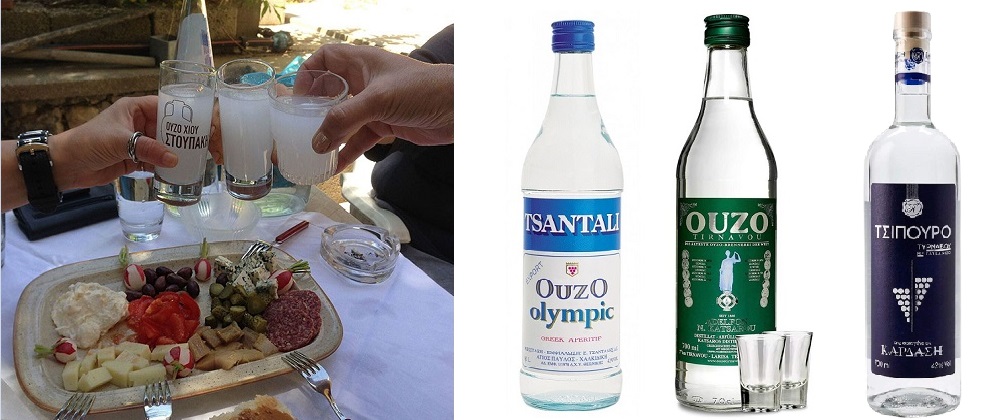This spirit, which is protected within the EU, is one of the best-known alcoholic drinks in Greece and is considered the national drink there. The name is presumably derived from the Turkish "üzüm" (bunch of grapes or grape juice). The history of ouzo production dates back to the 19th century, when merchant families from Asia Minor (Turkey) settled on Lesbos and began producing the distillate in stills made of bronze or copper. These influenced today's ouzo production. The popularity of ouzo increased enormously after the Greek-Turkish War in 1922.
Ouzo was exported to France flavoured with aniseed. It was exported to the port of Marseille in wooden crates with the Italian inscription "Uso di Massillia" (meaning "for use in Marseille"). According to a second version, the name was derived from this. And according to a third version, it is a corruption of the ancient Greek verb "ozo" ("I smell") or "ou zo" ("I do not live" - meaning "I cannot live without ouzo"). In the past, it was produced by double distillation of the press residue, so it was a pomace spirit like grappa or marc.

Production
This production method was subsequently changed in stages. Today, wine for distilling is the prescribed base material. Aromatic oils from aniseed or mastic resin as well as cinnamon, ginger, fennel and other aromatic substances are added to this before distillation and distilled up to three times. Each distillery (Amvyka) has its own, top-secret recipe. The quality and flavours of the ouzo are primarily determined by the size, type and material of the still, the quality of the alcohol and the combination of flavourings. From the first distillation, only the "heart" (middle fraction) is used for the second and third distillation or stored for ageing.
After maturation, the high-proof product is mixed with water before bottling to bring it to an alcohol content of around 40% by volume; a minimum of 37.5% is prescribed. Higher quality ouzo is sometimes stored for several years. Until 2008, ouzo had to be colourless and had to have a maximum sugar content of 50 g/l. Ouzo may only be produced under this designation in Greece and Cyprus. The tsipouro produced in Macedonia (tsikoudia in Crete) is similar to ouzo, but is traditionally made from marc.
Flavour
In Greece, ouzo is rarely drunk on its own as a digestif. It is usually served with mezedes (small dishes such as octopus or cheese), where it is diluted with water and/or ice. This creates the typical milky discolouration (the so-called louche effect or ouzo effect). This is a purely visual phenomenon. In some areas of Greece, such as Crete or Rhodes, ouzo is also added to coffee as a shot.
Producers
There are around 300 producers. There are particularly many on the island of Lesbos, where around half of the total production comes from. Well-known brands include Barbayanni (with an ouzo museum), Deka, Jassas, Loukatos, Mini, Ouzo 12, Pilavas, Plomari, Tirnavou and Tsantali (with the "Olympic" brand). Germany alone imports around 10 million bottles per year.
Further information
For the production of alcoholic beverages, see Champagne (sparkling wines), Distillation (distillates), Speciality wines, Spirits (types), Winemaking (wines and wine types) and Wine law (wine law issues).
Image left: from Νικόλαος Αντωνόπουλος on Pixabay
Source (in part): WIKIPEDIA Ouzo
Voices of our members

For my many years of work as an editor with a wine and culinary focus, I always like to inform myself about special questions at Wine lexicon. Spontaneous reading and following links often leads to exciting discoveries in the wide world of wine.
Dr. Christa Hanten
Fachjournalistin, Lektorin und Verkosterin, Wien